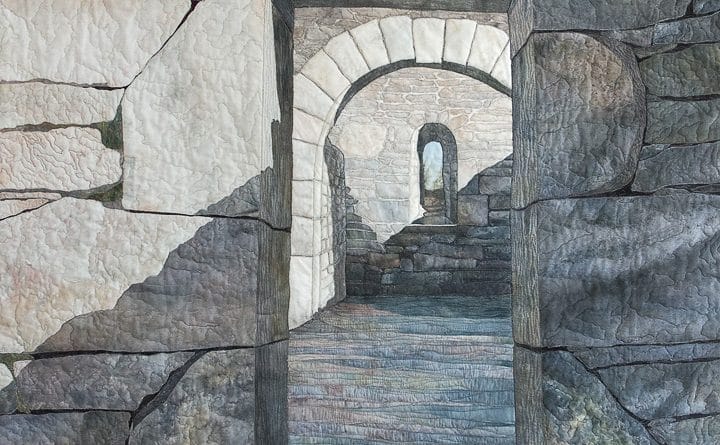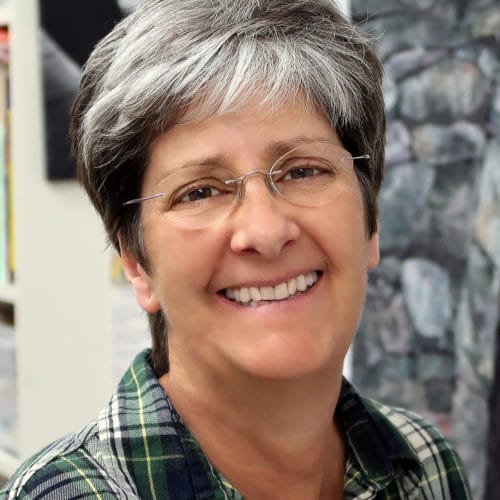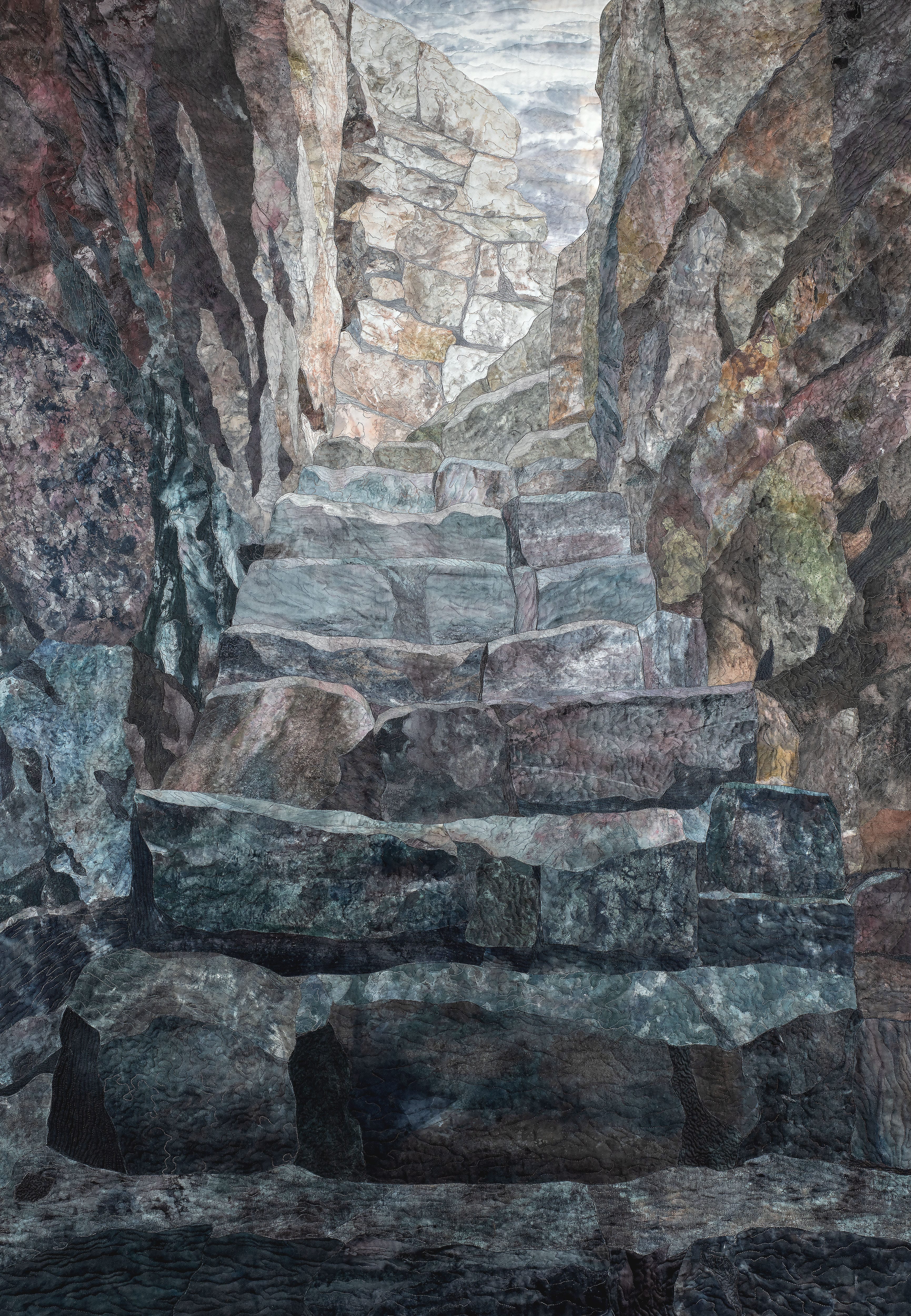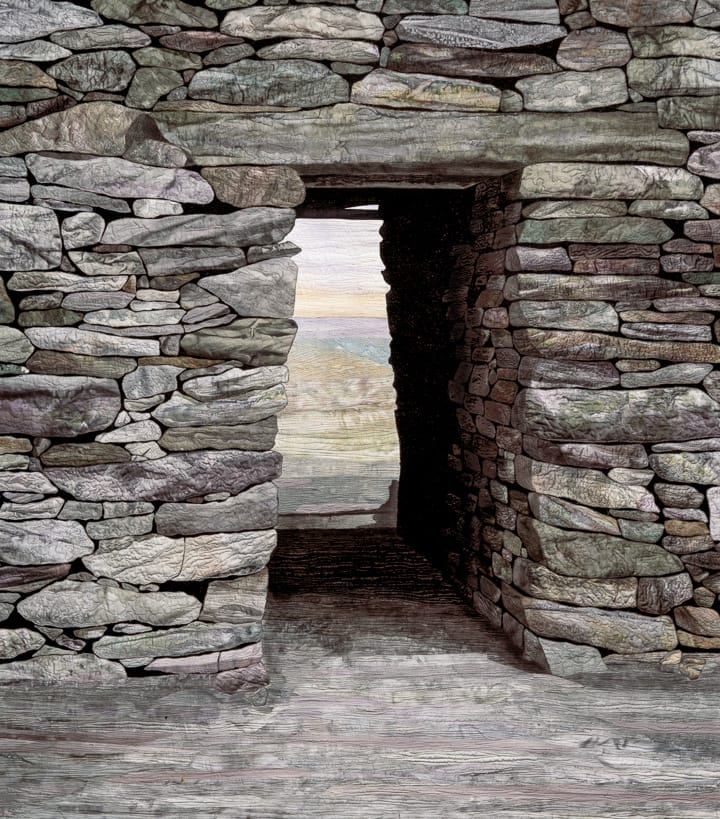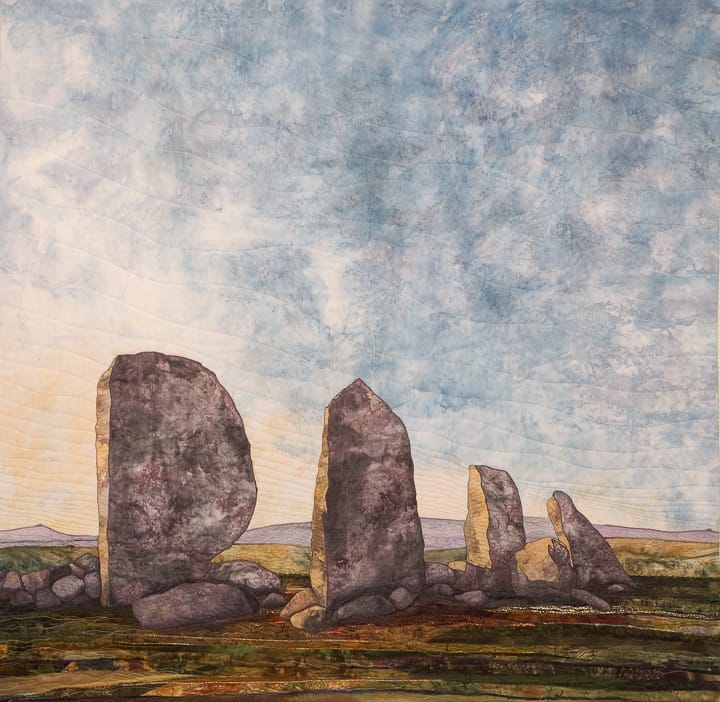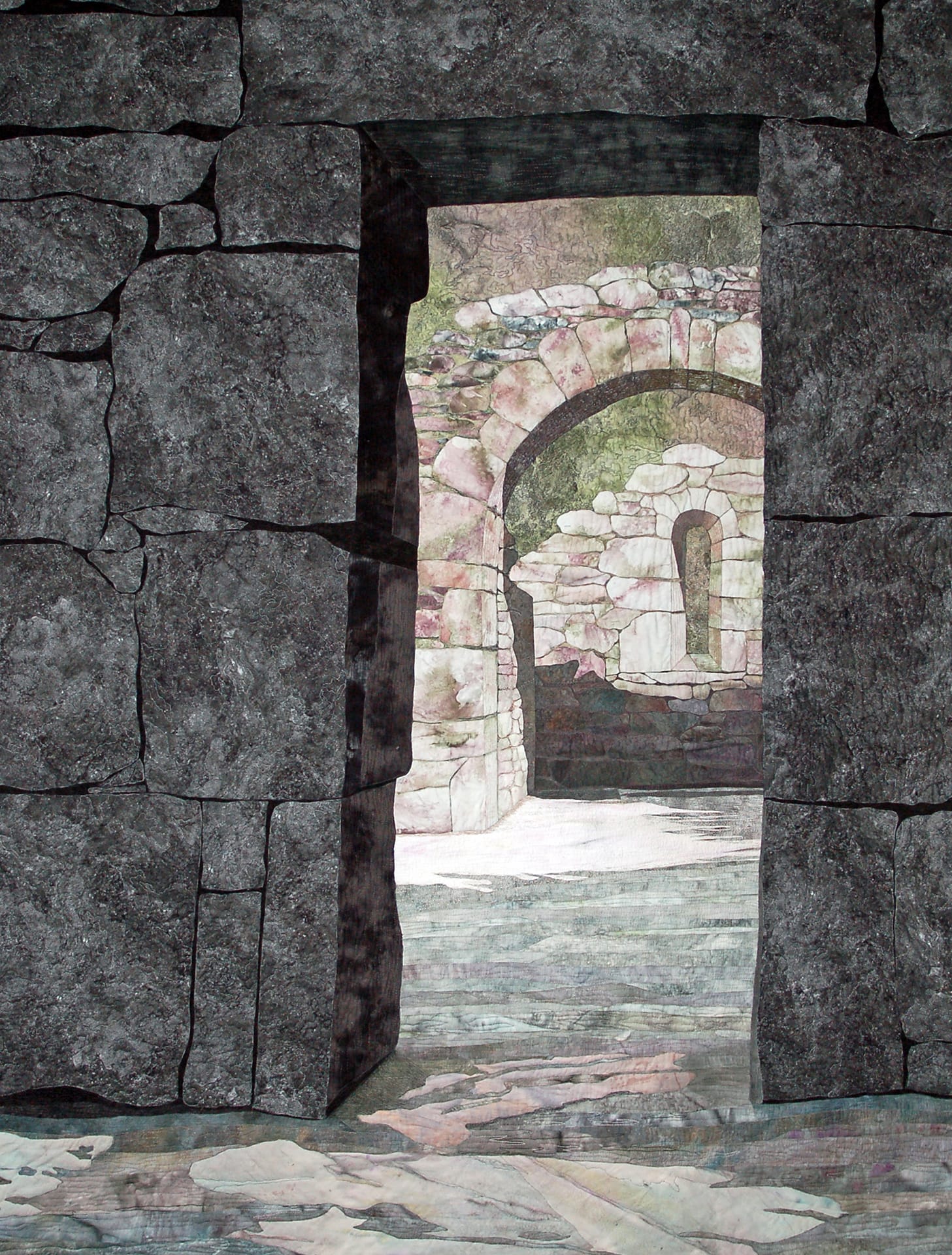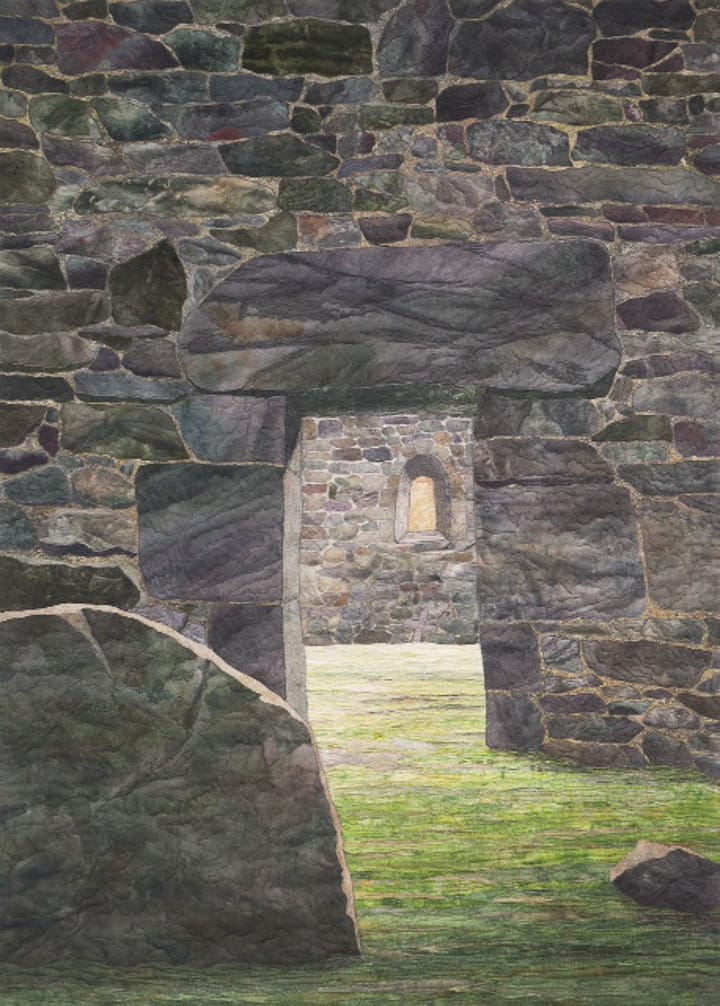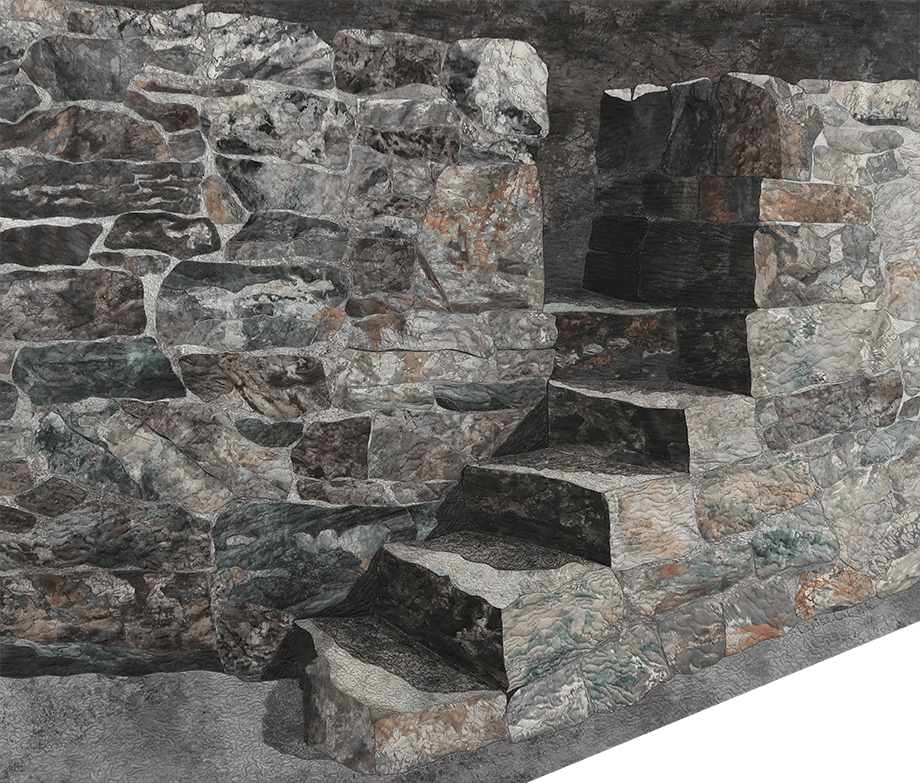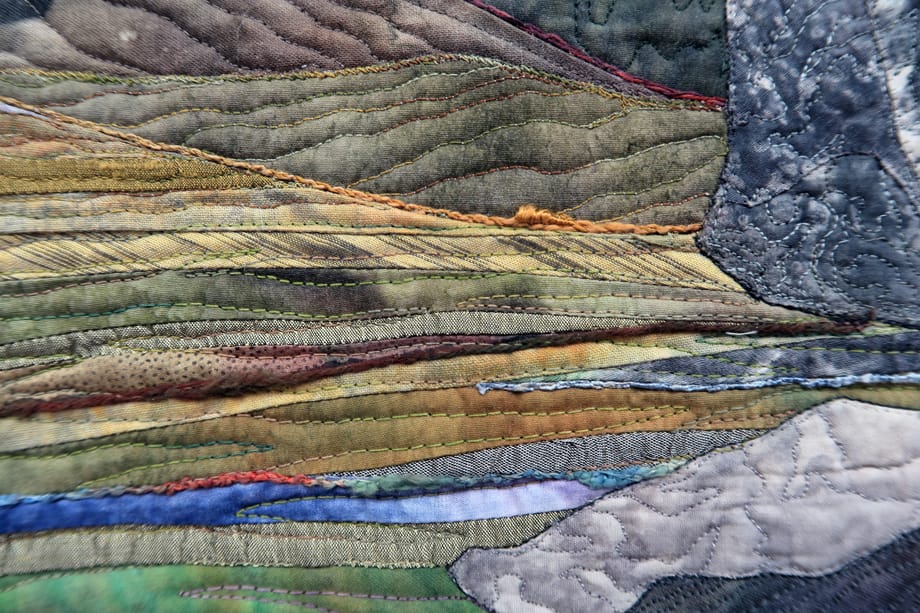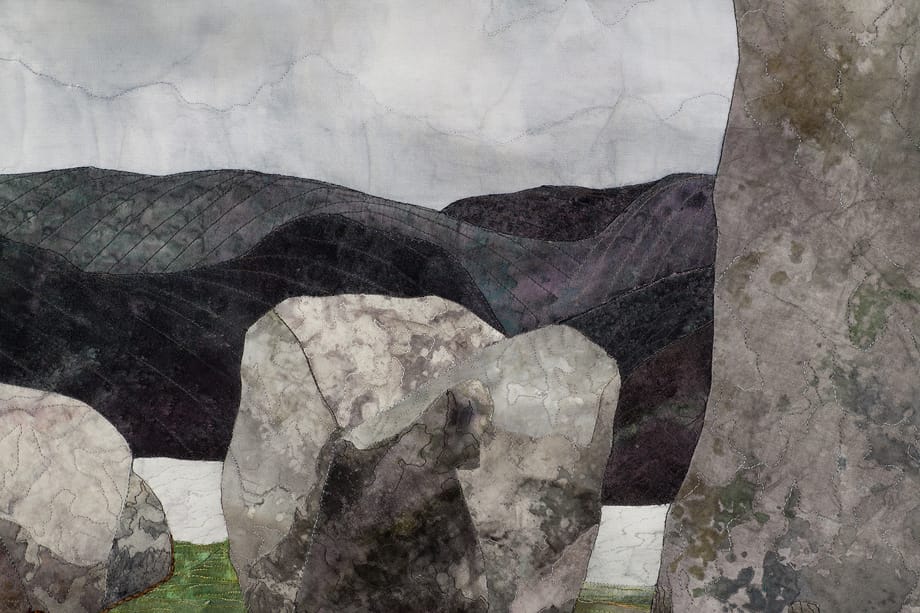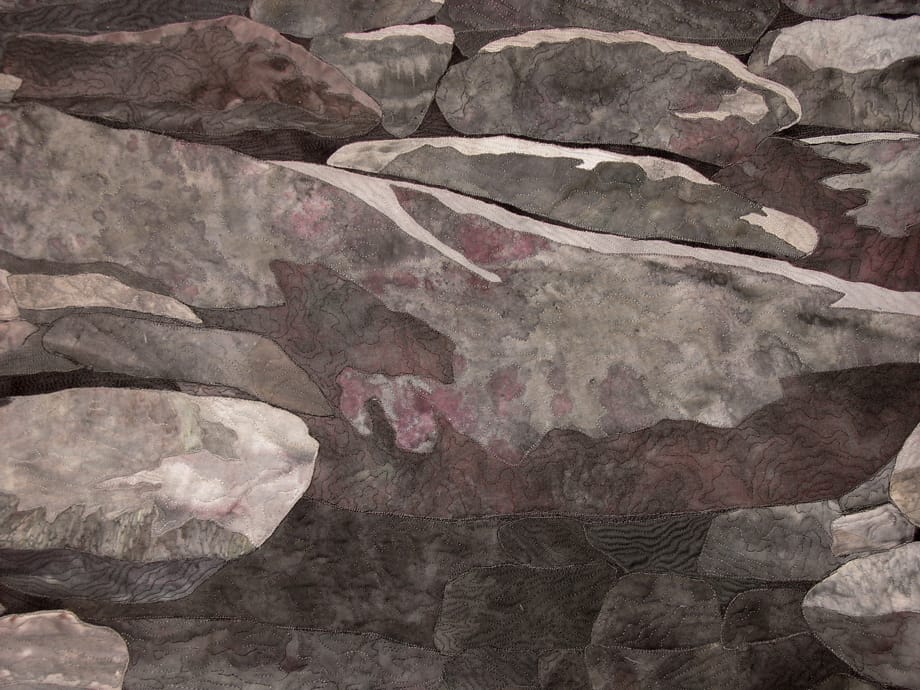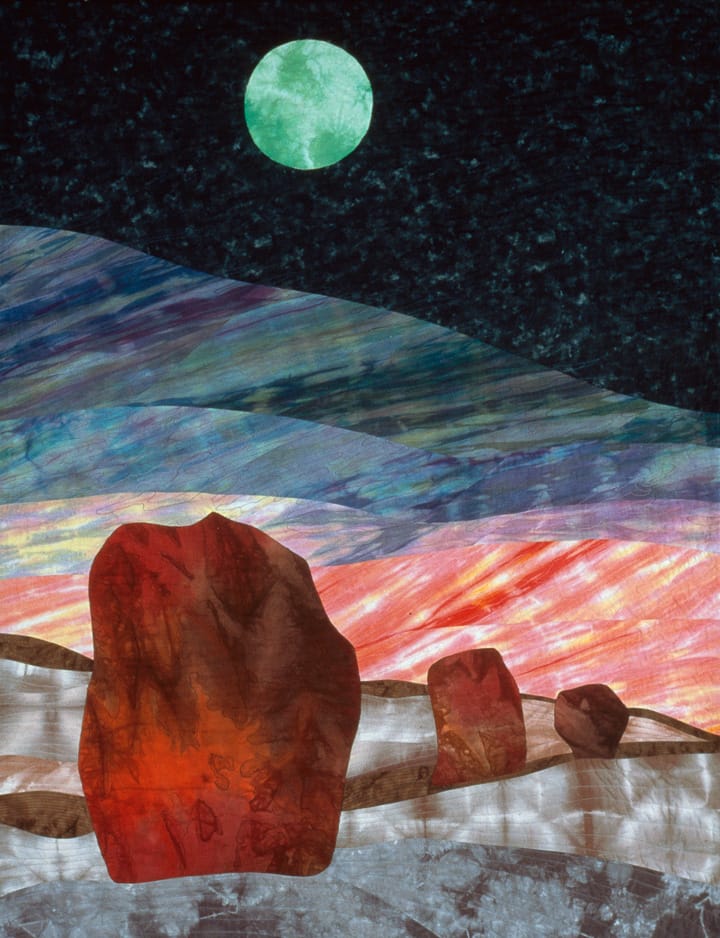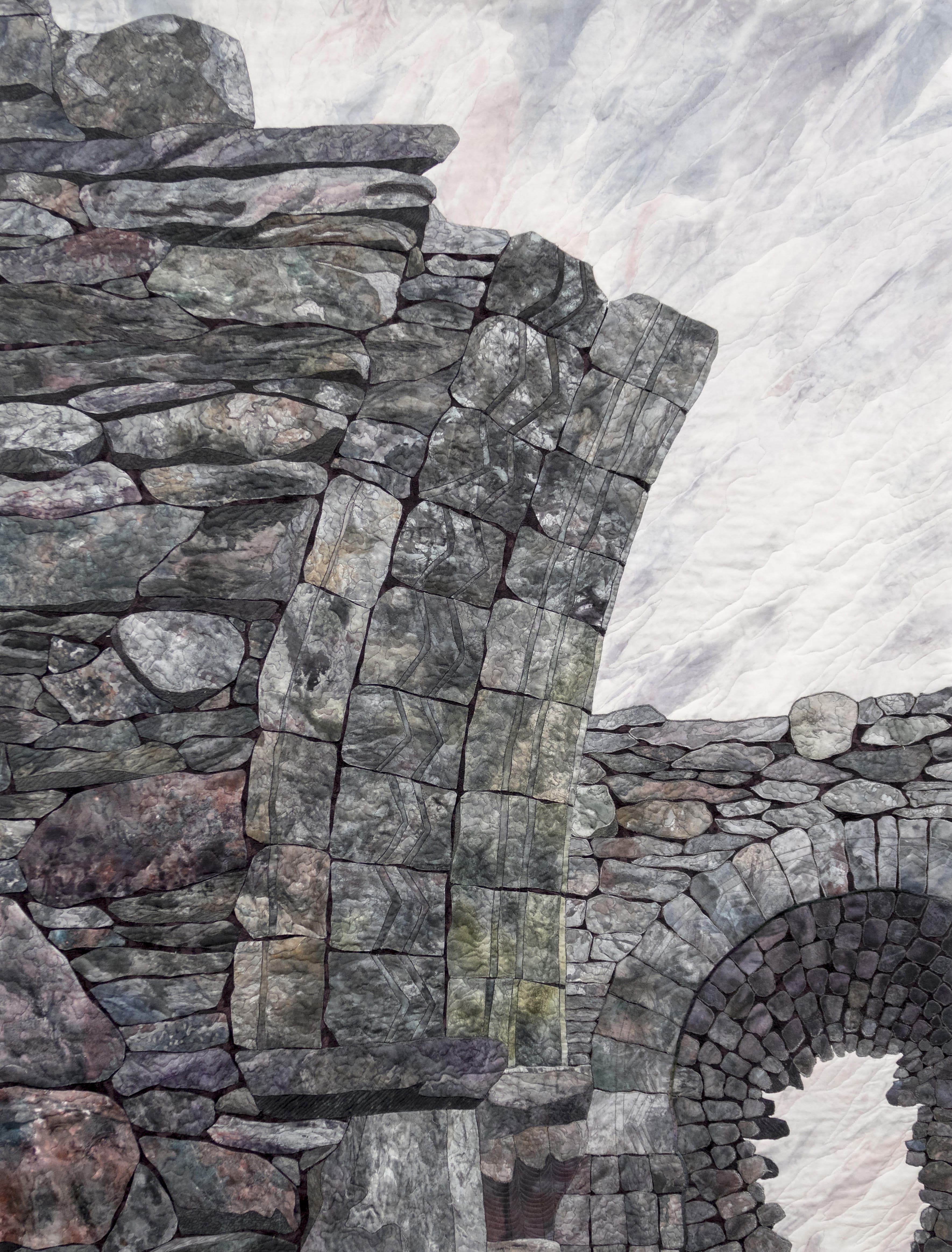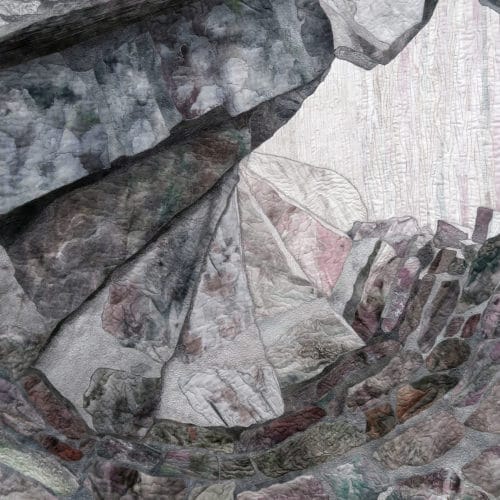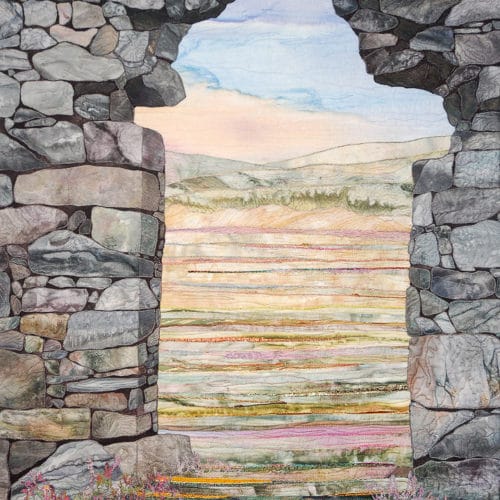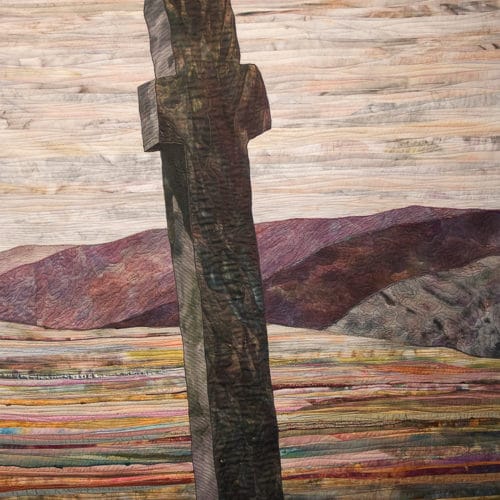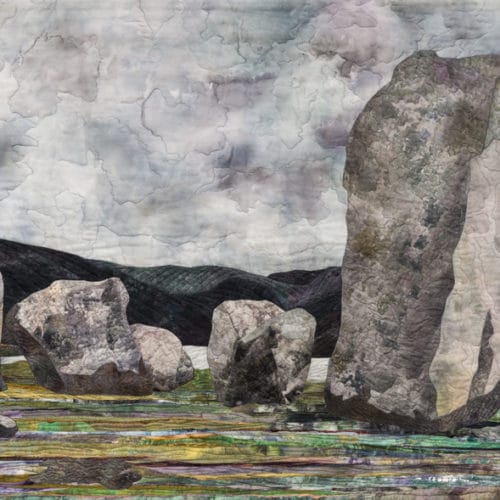Interview with Denise Labadie
An internationally recognized artist and textile teacher, Denise began creating art quilts in the 1990s. Her work has been exhibited in prestigious national and international exhibitions and published in numerous trade publications.
Diane has a deep connection to the ancient Irish landscape. The subjects of her art quilts are imposing megalithic stones, dolmens, Celtic crosses and ruins of ancient churches. The enigmatic megalithic culture brings with it the feeling of being in front of a great historical rebus still unresolved that exerts a magical attraction on the artist. These are the elements that found her artwork and inform her poetics, and that with skill and passion Denise proposes in infinite different shades through the textile medium.
To best honor these ancient icons, to express the moods and textures inherent in these complex landscapes, uses a wide variety of colors, fabrics and threads. She paints and quilts each stone by hand to achieve the most realistic look possible, while developing the most abstract landscapes using a stripping technique that uniquely mimics the intimacy, shadows, tones and chromatic tones so common to Irish views.
This is the link to the artist’s website:
Denise Labadie
Denise, how (and why) did you approach quilting? Why the choice of this technique as a means for your creativity?
I have always loved both fabric – touching it, creating with it – and sewing. I started sewing doll clothes asa child, andbecame a professional seamstress early on. I still love just being at the sewing machine, working with fabric, late into the night.
Working as a professional seamstress, however, I eventually wanted to stop sewing for other people and instead focus on using my craftsmanship as a starting point for creating my own art. I didn’t know at the time what the theme of that art might be or where it might take me … only that it would involve sewing and fabric.
Art quilting gave me the opportunity to use my sewing to create art in a totally new, but still hands-on, way.
For years I did hand quilted, traditional small patchwork pieces as a hobby. Then I saw what people were doing using modern fabrics within traditional patterns. I also saw how the advent and freedom of the rotary cutter made moving away from rigid patterns possible.The result was unbridled, and previously unavailable, creative opportunity. I was captivated.
So I started at the sewing-first end of the art quilting spectrum rather than seeing art quilting as a medium uniquely capable of allowing me to deliver on, or achieve, a particular or preconceived artistic vision. Instead, I wanted to see how I could blend and integrate all these evolvingsewing, fabric, technical, and artistic trends with my own craftsmanship, makingthe resulting collage my own.
When I discovered and decided to pursue art quilting (in the early 1990’s), I was thus already quite competent as a seamstress, but I had little background or formal training in art. I believed, however, (and still do, more than ever) that an artist must be fully schooled in the basics, and be absolutely comfortable with both their chosen mediumand (at least a minimum set of) associated techniques, in order to allow one’s creativity to not only fully surface – without conscious thought or undue constraint – but to “see” compositionalsolutions that might otherwise go unheeded. SoI developed and followed a deliberate plan to acquire “the basics”. Before I produced my first art quilt, I took not only “how to” quilting classes, but also selected design and art classes that covered key topics (e.g., drawing, painting, composition, color, perspective, shadowing, and the like) that I knew I would eventually need.
Importantly, I wanted to take classes to learn both composition and specific techniques, not to mimic other artists. I knew that I would eventually create my own unique style, and did not want to be unduly influenced by any particular “school” of thought or personality.
This was even before I discovered stones (see the next question about my focus on stones).
My quilting style began to take root. Stones and ruins became my passion, and my approach to quilting gained focus. I also came to understand that “successful” art very much requires a strong interplay between a personal inspiration and focus; a “trademark” style; and using one’s art and chosen medium to tell compelling stories in particularly effective or memorable ways – the result being an emotionality, and hopefully a soulfulness, that can take a viewer’s breath away.
“Piper Stones II”, 2001, 44″ wide x 54″ high, copyright Denise Labadie
When I show my quilts I often see viewers getting surprisingly emotional (no longer surprising to me, but certainly surprising to them!). It’s wonderful. Art has to be more than just “interesting”. It has to somehow move the viewer, evoke emotion, seem alive, make you feel or remember something important, make you want to go there, make you want to be there now, in the moment.
These viewer reactions and responses are why I continue to make quilts and, for me, why the free-form nature and creativity of the art quilting medium, along with it’s surprising (and, to me, pleasing) dependence on proper technique (both sewing-wise and artistically), allows me to tell stories with an emotionality that I could never achieve with other mediums.
Your works depict landscapes with stones or stone architectural structures. However the stone is your subject, why? Where does this need come from?
I am drawn to ancient stones, their landscapes, and their stories.
My great grandmother came to the US from Ireland, and my initial visit to Ireland affirmed a deep connection.It was while planning a second visit that I first saw a picture of the Piper Stones, a megalithic stone circle in Co. Wicklow, that sent shivers through me. I sought them out as soon as I could after my return. These stones – and later, many others – “talk to me”, and I’ve focused ever since on using my art to try to introduce people to these amazing structures and their ancient and emotional stories. I have come to similarly revere more recent monastic ruins (especially portals and passageways).
My quilts tend to (thematically) emphasize permanence and stability, and continuity, and whispered remembrances of human pasts largely forgotten. In each quilt I also try to capture each individual stone’s more private stories – notions of timelessness, patience, prior glory, magic, age (and aging), sadness, abandonment, neglect, and the like.
My goal is to create emotional, moody, stylized“stone portraits”. A number of my quilts have been purchased as meditation and healing tools. People also tell me that they feel the quilts actually “pulling them in”; that they want to go into and through them. The quilts seem to jostle some deep core of cellular memories, helping viewers remember what they already intuitively know and honor, but may have set aside or forgotten.
This multi-dimensional ability to impact viewersseems like a capability and result which art quilting is uniquely capable of delivering.
The color choice is mainly the same but sometimes the color get in your work. Representative or emotional need?
I was recently told “how brave I am to work in greys”. But I don’t work just in grey, or any single color; on closer inspection the stones are actually quite colorful, reflecting nature’s own complexity (and providing the quilt with significant textural nuance).Granular color and texturalcomplexity is central to my stones’ realism; in contrast, any landscape elements or skies are quite abstract (though oftentimes quite colorful), but are only sufficiently representative so as to establish or reinforce locational and environmental context and place, never competing with the stones themselves.
The stones’ stories and emotionality may be subtle – often just whispers – and the colors (and contrast and shadowing) that I use certainly reflect that messaging subtlety. But the color– which is both representative and emotional – is most definitely there, and plays a central role in each quilt’s overall design.
How does the creative process take place?
My style depends on the purposeful combination and integration of both well-practiced(sewing-related) craftsmanship and a strong foundational understanding of art fundamentals.
This combination allows me to bring together my fabric painting, quilt top construction, compositional techniques, and subjectmatter in a uniquely stylized way. It givesme the “glasses” to see and create different artistic possibilitiesand solutions that would not otherwise be apparent or visible.
Confidently knowing your craft – all aspects of it – actually fosters creativity, and allows you to tell the best, most effective, most dynamic stories possible. Understanding both sewing and art fundamentals is not constraining. It is liberating. It lets your creativity come to the forefront, lets your native talent show through, and makes your work more fun and more capable of being openly exploratory and innovative … you need to be able to put the “how” and “what” of quilting into your subconscious, all the while letting this knowledge help guide and make real your creative vision.
Technique and knowledge is not secondary to “artistic expression”. Combine a basic knowledge about art – color, perspective, composition, light and shadows, etc. – with good sewing and construction techniques, and your expressive creativity is unleashed.
Art doesn’t require a rigorous adherence to the basics, but it does require a rigorous understanding of the basics.
Playing with the basics – once you understand them – allows you to further evolve your own style, and (hopefully) makes your work memorable (in a good way!). And just like how a basic knowledge of your craft actually enhances creativity, creativity is also enhanced by the constraints imposed by working towards a signature style. For example, both perspective and “light management”(e.g., lighting, shadowing and contrast, color changes with depth, light intensity falloff, etc.) have become central to my compositions, but they are really hard for me. I’m just not a natural, but with every quilt I try to push both elements to new compositional (and thus stylistic) limits.Confronting my weaknesses makes me more creative, allowing an ever evolving personal style. I can’t imagine trying to deal with these limitations – or worse, being unaware of them – without the benefit of my prior training.
Finally, I also rely on intuition. A lot. Which, of course, is aided by technique and craftsmanship. A virtuous circle. Intuition is the stones talking to me.
“Irish Stone Fort Ruin”, 2010, 40″ wide x 48″ high, copyright Denise Labadie
What techniques do you use to make your works? Why did you choose to dye the fabrics?
I use a wide variety of colors, fabrics, threads, and yarns in my work, constructing the quilt the same way as a stone mason builds a wall – in my case, individually sizing and cutting out, piecing, and appliquéing each stone, one by one, working from the bottom up. I think this lets me create more realistic and interesting quilts, and also allows me to honor the original builders.
There just isn’t much commercial fabric, however, with the types of colors, textures, depth, and complexity that I need for my stones (or landscapes and skies), so I hand paint almost all my own fabric. I do not use dyes. Painting is both non-toxic and allows me – using multiple layers of transparent paint, plus various resists – the control to achievetextural complexities (similar to actual stone) that I couldn’t otherwise achieve. I do whatever it takes to aggressively influence or cause differential paint absorption, diffusion, blending, patterning, or mottling. Resulting fabrics can be remarkable.
I typically decide up front the color palette I want to use for each composition, and work from there.
I also typically work from photos – not as a template, but more as a rough guide to help with perspective and lighting.
As noted above, once I have my quilt-specific palette of painted fabric I then individually cut out and appliquémy stones. I use of variety of appliquétechniques. The goal is make my stones as realistic as possible. Turned edge appliquéhelps “pop” stones from the background. Raw edge appliquédoes exactly the opposite (in that it tends to flatten and fuse objects). And reverse appliquéallows the creation of “micro” shadowing and textures, giving each stone a dimensionality and “personality” not otherwise possible. I’ll often intermix two or even all three types of appliqué (or even insetting) on the same quilt, depending on the effect I’m trying to achieve.
In contrast to the realism of my stones, my skies and landscapes – which are central to the context of place and the timelessness of these sacred sites – are far more abstract. For my landscapes I use free-form strip piecing (and couching), integrating thin horizontal pieces of my own hand-painted fabric, trims, yarns, batiks, silks, metallics, whatever … into an abstract of colors and textures.Skies may be strip-pieced or based on single (large) pieces of purpose-specific painted fabric.
Do you remember your first quilt? What are the differences with your last job?
Yes. Before I even knew that I was attracted to stones, my first major quilt project was actually a traditional Irish Chain patchwork, which I modified and re-worked to have the diagonals be stone walls enclosing small cleared fields. Who knew?
Then, on my second trip to Ireland, I visited the Piper Stones stone circle. I was entranced, andbecame hooked on stones. My next quilt was of that same stone circle, and I have not stopped since– my current portfolio numbers over 50 stone quilts.
My workalso continues to evolve. My storytelling ability has significantly improved, my management of texture and color is far more nuanced, and my understanding of perspective and lighting– always my biggest challenges, yet which are also the techniques that in many ways define my work – is finally starting to mature.
The biggest difference between early on and today is that I now have an actual style that I bring to my quilting, whereas early on I had yet to develop any sort of signature theme or look. My passion, however, is stronger than ever as is my ever evolving ability to tell ever more compelling and emotional stories.
What are your future projects? What are you working on?
Now and in the future … staying with stones – telling more stories; refining and evolving my techniques; communicating even more emotion; going larger; and placing even moreemphasis on portals and passageways.
